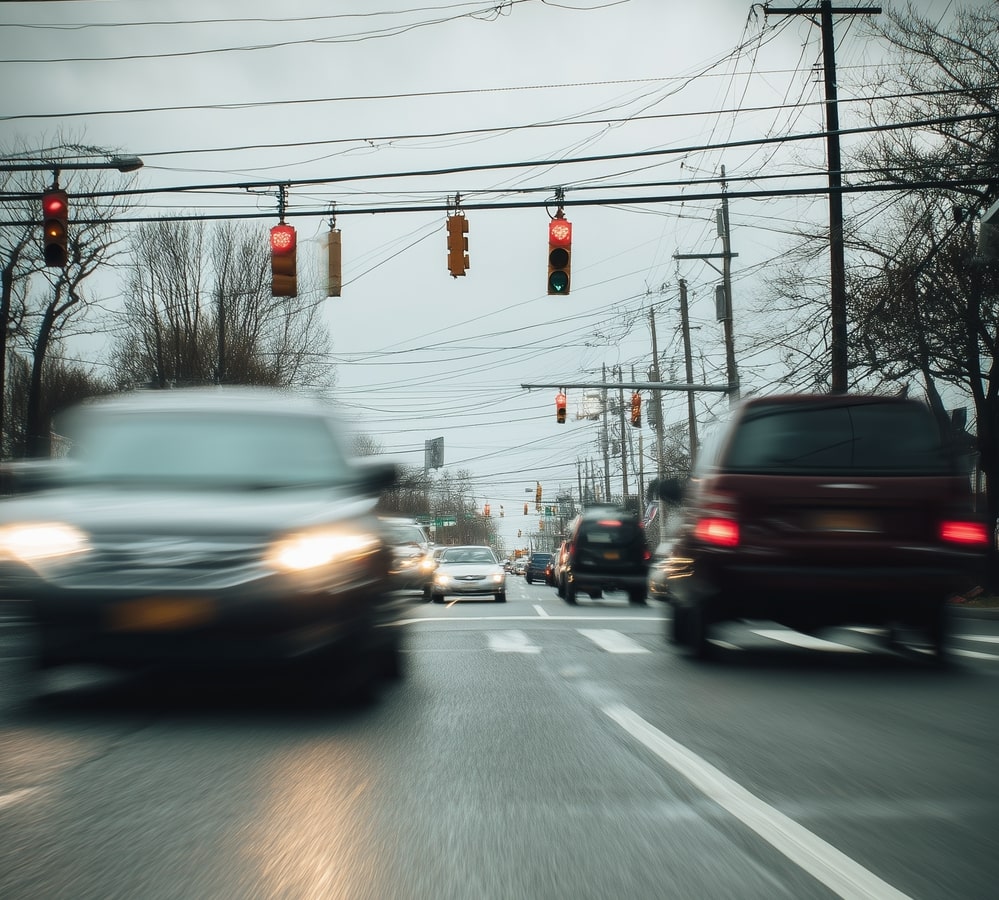Failure to Yield Accidents in Maryland

Traffic rules are often quite explicit. For example, if you and another driver arrive at a four-way stop at the same time, you are legally required to yield to the other driver if they are to your right.
These strict rules don’t only exist so that Maryland can get income from issuing traffic citations. They exist to protect the well-being of every driver and passenger on the road by preventing failure to yield accidents in Maryland.
What Is Failure to Yield?
Both general and specific traffic rules specify when a driver has the right-of-way or should yield it to another driver. When the regulations dictate that you are supposed to yield the right-of-way, you are expected to slow down or stop, as necessary, to allow another driver to proceed.
When you fail to do this, you are creating a dangerous situation by driving on a section of road where another driver believes there should be no vehicles. You would likely be liable for any failure to yield accidents in Maryland caused by this behavior.
Other vehicles aren’t the only types of entities you might need to give the right-of-way to. Right-of-way laws also cover interactions with pedestrians and bicyclists who are legally using the road. This means you need to be just as cognizant of the regulations regarding pedestrians or bicyclists as you are of the regulations regarding other vehicles.
Examples of Failure to Yield Accidents
Failure to yield accidents in Maryland occur when a driver violates Maryland right-of-way laws. The following are common examples of these types of collisions.
Merging
When you are entering another road, you are expected to give the right of way to vehicles already traveling on that road. This is most common with highways, but it can apply to smaller roads.
Exiting Driveways and Parking Lots
This is a specific type of merging. When entering a public road from a private parking lot or driveway, you are required to yield to any vehicle already on the road. If you are crossing a sidewalk to enter the road, you are also required to yield the right-of-way to pedestrians or bicyclists on the sidewalk.
Roundabouts or Traffic Circles
Roundabouts and traffic circles are treated like highways. If you are already in the roundabout, you have the right-of-way. If you are entering it, you must yield to other drivers.
Turning at Intersections
This primarily applies to drivers who are turning left at an intersection. Unless other right-of-way laws apply, when turning left, you must yield to other traffic. You also need to yield when turning right at an intersection, but typically not to opposing traffic.
Stop Signs and Traffic Lights
While ignoring a stop sign or a traffic light is a separate offense, you are also failing to yield when you ignore traffic control devices. This failure to yield is particularly likely to result in an accident because other drivers expect that these control devices will be respected.
Pedestrian Crossings
Pedestrians typically have the right-of-way at pedestrian crossings. This means that when you are approaching one, you should watch carefully for any pedestrians in a crosswalk or those who are about to enter.
Reasons Failure to Yield Accidents Happen
People rarely intend to get into an accident. Failure to yield accidents are usually the result of some type of negligence. If you can identify the signs of common causes of these collisions, you may be able to avoid getting into a failure to yield accident.
Distracted Driving
The world is filled with distractions for drivers. Too many drivers are looking at their phones, trying to enter information into their GPS, or eating a sandwich while driving. These types of distractions cause them to take their eyes off the road, which means they may not see other cars or pedestrians they are supposed to yield to.
Lack of Knowledge of Traffic Laws
Unfortunately, Maryland traffic laws are extensive. Drivers are regulated by hundreds of sections and thousands of individual rules. No driver, no matter how good, can understand every law on the books.
If you see a driver who seems unsure of themself while driving, you should probably give them a wide berth. They are less likely to be aware of right-of-way laws, which can result in an unfortunate accident.
Poor Visibility
Any time that visibility is limited, you should expect that other drivers are less likely to give you the right of way. Thus, if you are driving in a snowstorm or fog, another driver might not notice you. Driving at night creates similar problems, especially if your vehicle or another vehicle has any non-functioning lights.
Also, if you are riding a bicycle, a motorcycle, or walking, keep in mind that you have a smaller profile than cars or trucks do. Another driver might not yield the right of way to you because they don’t see you on the road. You should be particularly wary of larger vehicles with limited sight lines.
Aggressive Driving
Unfortunately, some drivers are just bad. You can identify these drivers when you see someone speeding, switching lanes without signaling, or braking with little notice. These drivers are unlikely to yield the right-of-way to you. While they would be at fault if they caused an accident, it is better to just stay away from aggressive drivers.
Driving Under the Influence
Finally, if someone is driving while drunk, they are almost certain not to give you the right-of-way. Drunk drivers exhibit almost all of the previously mentioned problems. They are typically more aggressive, don’t keep their eyes on the road, have impaired vision, and likely don’t remember all the traffic laws.
If you see someone who you believe is driving under the influence, stay as far away from them as possible. The safest thing you can do is pull your vehicle over and call the police to report their behavior.
Determining Fault After a Car Accident
If you are unlucky enough to be involved in a failure to yield accident in Maryland, you can obtain compensation for your injuries from the at-fault driver or their insurance company. However, before you can get any compensation, the insurance company or a lawyer will need to determine who was at fault.
Typically, this starts with an examination of the accident by an experienced investigating police officer. The officer is trying to reconstruct the accident scene to determine where each vehicle was, how they were moving, and who should have yielded the right-of-way.
Your car accident attorney will follow up speak with witnesses, examine an accident report if one exists, or try to uncover video evidence. Physical evidence, like damage to both vehicles, can also help put the pieces together.
If the evidence suggests that a single party was responsible, typically, the insurance company of the at-fault party will attempt to settle with all injured parties. But what happens if the evidence suggests that both parties were partially responsible?
Contributory Negligence Laws in Maryland
Unfortunately, Maryland uses one of the strictest standards in the country for determining whether someone is eligible to get compensation from another party: contributory negligence. Under this standard, if you are even slightly responsible for your injuries, you can’t recover damages from the other party.
This means that determining fault is critical after an accident. You want the evidence to definitively show that the other party was responsible. Simply failing to yield the right-of-way, however, may not be enough proof that they were responsible. If there is evidence that you were driving recklessly or carelessly, you could still be considered partially at fault.
Similarly, even if the other party was fully responsible for the accident, you could be partially responsible for your injuries. For example, if you weren’t wearing a seat belt, an insurance company might determine that you shared responsibility.
What Types of Compensation Can I Recover After a Failure to Yield Car Accident?
Assuming that you are eligible to get compensation, there are two types of compensation you can potentially receive: economic and non-economic damages.
Economic damages are compensation for provable financial losses or expenses that you experienced or will experience due to an injury. The most common examples of these are:
- Medical bills
- Lost wages or income
- Property damage
- Services or purchases required because of your injury
Economic damages need to be documented. If, for example, you miss two months of work because of a car accident injury, you need to provide documentation that your injury made it impossible for you to work. You would also need to provide evidence of how much money you would have made during those two months.
Non-economic damages are different. They represent things like physical or emotional pain and suffering. While there is no way to document a financial value for this type of pain, you can still receive compensation to make up for it.
However, Maryland places a cap on how much money in non-economic damages you can receive for a single accident. The current cap is just short of $1 million and increases by $15,000 every year. There is no cap, however, on economic damages.
Skilled Maryland Car Accident Law Firm
If you were seriously injured in a failure to yield car accident in Maryland, the law may allow you to get compensation from the other driver and their insurance company. However, with the way that contributory negligence rules are applied, getting that compensation can be difficult.
Your best chance to get fair compensation after a failure to yield accident in Maryland is to be represented by an experienced car accident attorney who has a strong record of winning these types of cases. John Leppler at Leppler Injury Law knows how to support victims in these types of cases and guide them through the legal process.
Don’t let the insurance companies take advantage of you after getting hurt in a failure to yield accident. Contact Leppler Injury Law to schedule a free consultation as soon as possible.
